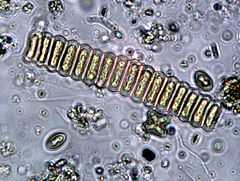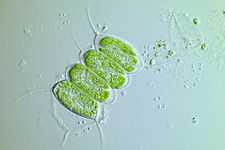Scenedesmus
| Scenedesmus | |
|---|---|
 | |
| Scenedesmus bijunga | |
| Scientific classification | |
| Domain: | Eukaryota |
| Kingdom: | Plantae |
| Phylum: | Chlorophyta |
| Class: | Chlorophyceae |
| Order: | Sphaeropleales |
| Family: | Scenedesmaceae |
| Genus: | Scenedesmus Meyen, 1829 |
| Type species | |
| Scenedesmus obtusus Meyen, 1829 | |
| Species | |
| |
Scenedesmus is a genus of algae, specifically of the Chlorophyceae. They are colonial and non-motile.
Taxonomy
Currently, there are 74 taxonomically accepted species of Scenedesmus.[1] Additionally, several subgenera have been identified, but vary according to the source. Hegewald denotes Acutodesmus, Desmodesmus, and Scenedesmus as the three major categories. Acutodesmus is characterized as having acute cell poles, while Desmodesmus and Scenedesmus have obtuse/truncated cell poles (differentiated by the presence or absence of spines respectively). Fossil records date Scenedesmus from 70 to 100 million years ago with Desmodesmus suspected to be the youngest of these three groups.[2]
Basic Biology
Scenedesmus is one of the most common freshwater genera; however, the extremely diverse morphologies found among species make identification and understanding of their mechanisms difficult.[3] While most species are found across the world, certain species exist only in local populations such as S. intermedius and S. serratus which are found in New Zealand.[4] Coenobia and Cell Growth Scenedesmus sp. can exist in a unicell stage; however, they also frequently found in coenobia of four or eight cells.[5] Coenobia are formed inside the mother cell wall and released to form either a new colony or disperse as unicells. The mother cell is either rapidly disintegrated or may remain colonial.[6] Different forms of coenobia are found including linear, costulatoid, irregular, alternating, or dactylococcoid patterns (Figure 1).[7]
The formation of colonies as opposed to unicellularity is dependent on a number of factors. A higher proportion of unicellular organisms was found at high light intensities and high temperatures, suggesting that at higher growth rates these organisms prefer to be non-colonized.[8] Coenobia with eight cells were not found in cultures with a growth rate below 0.6 day-1 but were prevalent at slower growth rates of 0.9-1.0 day-1.[9] Successful growth and division for algae relies on a balance between maintaining buoyancy in the euphotic zone (which contains ideal light and nutritional conditions) and avoidance of grazing predators.[10] Larger colonies have a smaller surface-to-volume ratio which limits nutrient uptake and light harvesting and the larger mass of the colony promotes sinking. However, in the presence of grazers such as Daphnia that threaten to consume unicellular algae, the larger colonies provide significant security.[11] This threat can be so significant that the cells will coalesce into 8-cell coenobia even in severely limiting growth conditions (coenobia are not formed by unicells aggregating, but by vegetative growth of a unicell ) [12] Defensory Mechanisms The cells do have other mechanisms of self-defense aside from colonizing. These include thickening of the cell wall and mucilage, spines, formation of a net by the bristles, and presenting a toxicity to certain organisms upon consumption.[13] Cells enter a defensive mode when kairomones are detected, an infochemical released by Daphnia that Scenedesmus has evolved to recognize as a warning signal.[14] Defensive strategies may also be constitutive under predictable conditions such as areas with constant threat of predators [15] Reproduction and Colony Formation During replication, several daughter cells form inside every parent cell and develop as non-motile autospores.[16] Scenedesmus progresses through a typical mitotic cycle similar to other members of Chlorophyceae except for a few key points. There are several suspected differentiations that occur within a colony including the incredibly dense cytoplasm of daughter cells before they are released.[17] Eventually the tension of the developing cells breaks open the cell wall of the original cell and releases the spores which undergo a dramatic change to assimilate to normal cellular dimensions.[18] Another example is the tangible difference between cells on the outside of the coenobium and the interior cells that are not located on at either end which have different shapes and arrangements based on their position.[19] The outermost cells have spikes only in corner regions and only have the ability to adhere to one cell (while interior cells obviously connect to cells on either side).[20] This is single-sidedness is observed even when brought in contact with the other terminal of cell of the coenobium, indicating a clear differentiation between the two cell types.[21] How the cells adhere to one another during development is still unclear, but it is known that the Trilaminar Sheath (TLS, see “Cell Ornamentation and Outer Layers” for more information) is one of the first exterior structures to form.[22] The TLS begins developing independently at future sites of adhesion between members of the colony and then grows to connect to one continuous layer.[23] The ornamented layer forms subsequently and the cell wall is the last structure to develop [24]
Cell Ornamentation and Outer Layers
The exterior ornamentation is highly variable within the Scenedesmus genus; however, Staehelin et al. characterized two species in detail: S. pannonicus and S. longus. S. pannonicus is observed with a tight-fitting “warty” layer compared to the loose “reticulate” layer found on S. longus.[25] A shared feature between the two is a “Trilaminar Sheath” (TLS) found at the junction between neighboring cells that helps cement them together.[26] There was an additional pectic layer observed on S. pannonicus which formed a thick mesh of thin filaments originating from the warty layer.[27] The pectic layer could be washed off, although complete removal of this layer requires a concerted effort.[28] Another feature of the outer coenobial surface on S. pannonicus is a combination of individual spikes (seemingly connected to the warts) and small spikelets that fuse to form combs that zigzag along the cell.[29] An overview of these structures can be seen in Figure 2. The last major category of ornamentation are rosettes that are common to many Scenedesmus species.[30] Rosettes are ring-shaped structures enclosing small mounds on the cell surface and are usually sitting upon a thicker layer of cell wall than the surrounding areas.[31] No potential function for these structures has been mentioned. While S. longus was not observed with the comb-like structures of S. pannonicus, it did have two variations of propping spikelets forming between the TLS and reticulate layer to keep the two apart.[32]
Image gallery
-

Scenedesmus quadricauda
-

Scenedesmus brasiliensis
-

-

-

References
- ↑ (Guiry 2013)
- ↑ (Hegewald 1997)
- ↑ (Lürling 1999)
- ↑ (Hegewald 1997)
- ↑ (Lürling 1999)
- ↑ (Lürling, ch. 6, 1999)
- ↑ (Lürling 1999)
- ↑ (Lürling, ch. 4, 1999)
- ↑ (Lürling, ch.4, 1999)
- ↑ (Lürling ch. 6, 1999)
- ↑ (Lürling 1999)
- ↑ (Lürling, ch. 4, 1999)
- ↑ (Lürling, ch. 6, 1999)
- ↑ (Lürling, ch. 9, 1999)
- ↑ (Lürling, ch. 6, 1999).
- ↑ (Pickett-Heaps 1975)
- ↑ (Pickett-Heaps 1975)
- ↑ (Pickett-Heaps 1975)
- ↑ (Pickett-Heaps 1975)
- ↑ (Pickett-Heaps 1975)
- ↑ (Pickett-Heaps 1975)
- ↑ (Pickett-Heaps 1975)
- ↑ (Pickett-Heaps 1975)
- ↑ (Pickett-Heaps 1975).
- ↑ (Staehelin 1975)
- ↑ (Staehelin 1975)
- ↑ (Staehelin 1975)
- ↑ (Staehelin 1975)
- ↑ (Staehelin 1975)
- ↑ (Staehelin 1975)
- ↑ (Staehelin 1975)
- ↑ (Staehelin 1975)
- "Scenedesmus". Integrated Taxonomic Information System. Retrieved 19 September 2007.
- D. Garbary and E. Hegewald (17 Aug 2004). "Scenedesmus Genus detail". AlgaeBase. Retrieved 2007-09-19.
- Hegewald, Eberhard H. "Taxonomy and Phylogeny of Scenedesmus." The Korean Journal of Phycology 12.4 (1997): 235-46.
- Pickett-Heaps, Jeremy D., and L. Andrew Staehelin. "The Ultrastructure of Scenedesmus (Chlorophyceae). II. Cell Division and Colony Formation.” Journal of Phycology 11.2 (1975): 186-202.
- Lürling, Miquel. The Smell of Water: Grazer-Induced Colony Formation in Scenedesmus. Thesis. Agricultural University of Wageningen, 1999.
- M.D. Guiry in Guiry, M.D. & Guiry, G.M. 2013. AlgaeBase. World-wide electronic publication, National University of Ireland, Galway. http://www.algaebase.org; searched on 3 May 2013.
- Staehelin, L. Andrew, and Jeremy D. Pickett-Heaps. "The Ultrastructure of Scenedesmus (Chlorophyceae). I. Species With The "Reticulate" or "Warty" Type of Ornamental Layer." Journal of Phycology 11 (1975): 163-85.